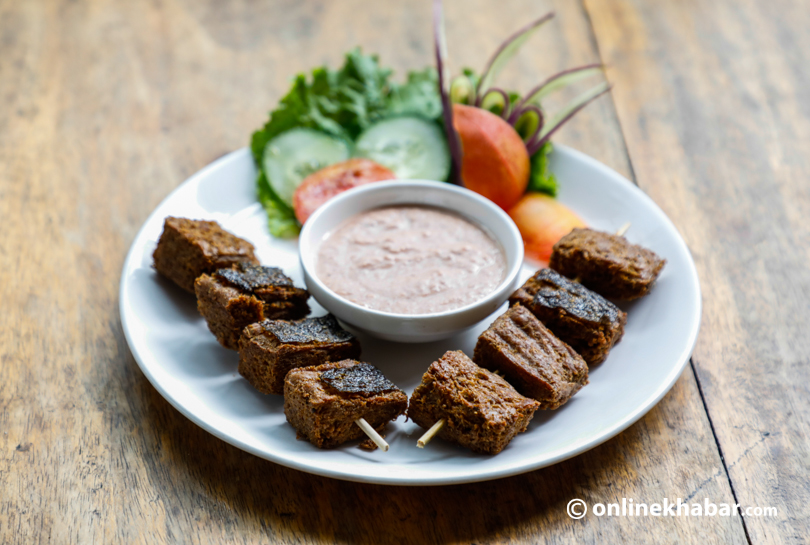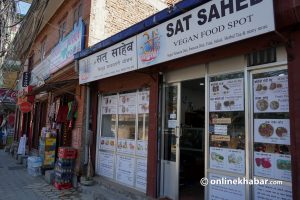On September 22, 2021, Nepal Police arrested four persons for slaughtering a cow, in Goldhunga of Kathmandu.
Slaughtering of a cow or oxen has been prohibited in Nepal under section 289 of The Criminal Code, 2017. An individual found guilty of this crime has to serve three years in jail.
However, slaughtering is not the only form of violence happening against animals, share animal rights activists. Many of them think animals are used as machines in commercial dairy and poultry farms. This realisation has given the rise to veganism in Nepal.
Although there are lots of (lacto-)vegetarians who consume milk and milk products, veganism in Nepal is essentially a new idea. Hence, vegans complain there are many doubts and myths surrounding their lifestyle in Nepal, which they say they are fighting to disprove.
Animal-sourced food and cruelty
It is claimed that there happens no cruelty against animals, especially cows and buffaloes at Nepali farms and households while rearing them. But, this is a false claim, informs Suresh Prasad Sharma, the chairperson of the World Vegan Organisation, Nepal.
“I was one of them initially. I used to think at least cows are a protected animal in Nepal; therefore, there is no harm in using dairy products,” Anish Tuladhar, the co-owner of the Sara Bakes and a yoga instructor, says.
Meanwhile, Tuladhar learned later that yak calves are separated from their mothers and starved to death to save their mothers’ milk for trade. Then, to make the yak release the milk, either a dead or starved calf is brought in front of the mother yak. “She is in so much pain because of seeing a calf in such a situation; she releases all the milk thinking the calf will survive by having that milk,” narrates Tuladhar, “This opened my mind. A cruel thing is happening. Because we are demanding for dairy, mothers, and calves are separated.”

The same happens with small farms with around 10 cows also, he claims. In order to sell milk, the cows are impregnated every year. It means, there will be 10 new calves and in the span of five years, the number of calves there will be 50. He then questions, “Has any dairy farmer kept all those 50 calves? No, either they are abandoned or mercilessly killed. Is this not cruelty?”
Further, the cows are forcibly and unnaturally impregnated via artificial insemination that requires veterinary doctors or farmers to insert nearly their entire arms into the cow’s rectums. “I call it a rape.”
Corroborating Suresh Prasad Sharma’s claim, Dipesh Shrestha, an animal rights activist, says although the animals were treated as pets in the past, commercialisation has changed this. Cows and buffaloes were given names, fed on grass, set free to graze on pasture lands, but coming to this stage, Nepal has already adapted factory farming.
Also, eating non-vegetarian food was a luxury in Nepal then. However, now, many people tend to eat that every day. This increasing demand for meat has eventually normalised the cruelty, he says.
Sharma also narrates the animals are not fed grass, instead fed on grains like humans, neither can they graze as openly as they used to years ago. They are confined to the farms now.
“We are spending around eight kilos of grains to produce one kg meat. Around 70 per cent of the grains produced in the world are being consumed by animals (farmed), contributing to the growing hunger issues worldwide,” according to Sharma.
Affordability, nutritional values, and variety
Another criticism that vegans face in Nepal is the vegan food items are neither nutritious nor various. Further, people think they are not affordable.
But, Sharma says vegan food is not costly. Probably, people have doubted its affordability due to two reasons. First, the vegan population is so low that people think this is a luxury group. Further, the other reason is that many vegan people tend to share photos or videos of expensive and exotic vegan food.
“But, the reality is not that,” stresses Sharma, “Everyone knows about vegetarian food, just remove costly food products, dairy products from it, it will be vegan food.”

He calculates, “It costs around Rs 100 for a litre of cow’s milk. On the other hand, soya bean costs about Rs 90 per kg and one can extract four litres of soya milk from one kilo of soya bean. The result is clear.”
Anish Tuladhar views affordability as a subjective matter. “But, in the context of Nepal, it is not expensive at all. We eat vegetables and grains every day,” according to Tuladhar.
Another “lie” that is prevalent among non-vegan people is that one does not get sufficient protein from vegan food, claims Sharma. But, one can directly get protein from plants multiple beans and broccoli.
For calcium, rice milk, soya milk, coconut milk, almond milk, oat milk, and milk extracted from different beans can be consumed. For omega3, flax seeds can be eaten, according to Sharma.
Talking about its variety, Tuladhar, who turned vegan in 2015, says, “People are used to having meals around non–vegan stuff. But if you start looking for or trying out vegan food, there are so many things.”
When he turned vegan, he says that there were no vegan options for cakes, pastries, and other bakery items in Kathmandu. “However, we know it can be made, but it was not available here. There were so many vegans so we started Sara Bakes Vegan in 2018. It actually tastes better than non-vegan cakes. Most of our customers are non-vegans.”
Tracing the origin of veganism in Nepal
Many people consider veganism in Nepal as an imported western concept, which Dipesh Shrestha says is a big myth. The main philosophy of veganism is not to give pain to other beings and not to exploit them and this is the core of eastern philosophy, according to him.
Neglecting veganism in Nepal, considering it as a western concept, is no different than not raising voices on women’s equal rights, taking feminism as western philosophy, he argues. It is not a country or region-specific issue, but a worldwide issue that needs to be addressed.
People also have another misconception that veganism in Nepal talks about giving equal rights to other species like humans. But, that is not the case. It says that all species should be given at least two rights, the right to life and the right to live without being exploited, says Shrestha.
Dipesh Shrestha says there are anti-vegan myths in society because a child is taught that animals are for human consumption whereas some others are pets. “This divides the love for animals. All this leads to seeing animals not as our companions, but as a way of earning money and fulfilling our greed.”
Anish Tuladhar adds, “Media and textbooks also reinforce those lies and we blindly abide by them. But, why did they lie? Because it is all about money.”
These are big businesses. So many animals are slaughtered every year, and each and every being is converted into money. He also argues meat and dairy industrialists also resort to funding university research works and hence their findings are biased.

























